Every now and then I get a question on how to wash an antique or vintage quilt. It makes people nervous, but I'm glad for that, because I would rather that the caretakers of these precious textiles think twice before tossing in them in washing machine with no thought whatsoever!
Below is some basic info about what has worked for me. Of course, there is lots more detailed info on line, so be sure to see what other info you can find.
First of all, a few tips of what NOT to do:
- Do NOT dry clean! Vintage textiles are way too fragile for the harsh chemicals used in dry cleaning.
- Do NOT use fabric softener or dryer sheets! I just about croaked when a customer dropped off a quilt for repair that had been machine washed and dried with fabric softener and dryer sheets. :( They leave a nasty residue on these fabrics (and on our clothes as well!).
That being said, you CAN wash an older quilt in your washing machine if you follow the tips below. It's really difficult to get a quilt clean and rinsed completely when washing by hand in the bathtub, so it's fine to use your machine as long as you take care when doing so.
- First of all, be sure to mend any open seams or tears before washing. Otherwise, these areas will only get worse when washed.
- Use a gentle detergent. Many quilt experts swear by Ovus Paste. Most quilt shops carry it, or you can purchase it at your local farm supply store because, believe it or not, it's also used for washing horses! I personally would avoid Woolite and laundry detergents designed for babies because they really aren't that safe or gentle. More recently, I have been using Norwex's laundry detergent with good results; it doesn't contain fillers and it rinses out easily, which eases my concerns.
- Wash in the machine with cold water on gentle cycle. The most important thing is to take care when removing it from the machine. A wet quilt is heavy, and wet fibers are fragile. I usually take a sheet and place it under the quilt while it's still in the machine before removing it. Then, remove from the machine by holding onto the sheet, not the quilt. That way, there is no stress on the weak fibers.
- Then, I carefully lay it flat to dry, squaring it up if possible. Never hang a quilt to dry. You can dry it outside with a a sheet underneath, but I'm always concerned about bug or bird dirt. If you have enough space indoors, lay it flat and allow it to dry. A fan or dehumidifier is helpful in speeding up the drying process.
Click here to read another post I had written on the same subject a number of years ago. In this post I gave tips on protecting fraying fabrics or patches.
These recommendations are for quilts made out of cotton fabrics. If your quilt is made of satin or other non-washable fabrics, do not attempt to wash it! Dry cleaning isn't a good option either, so some people put a nylon stocking over their vacuum cleaner nozzle and remove dust and loose dirt by carefully vacuuming it.
Click here for more detailed info about this subject.
























